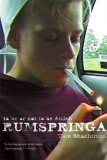Summary | Excerpt | Reviews | Beyond the Book | Readalikes | Genres & Themes | Author Bio

To Be or Not to Be Amish
by Tom Shachtman1
“Going Away”
In the gathering dusk of a warm, humid summer Friday evening in northern Indiana, small groups of Amish-born girls between the ages of sixteen and nineteen walk along straight country lanes that border flat fields of high cornstalks and alfalfa, dotted here and there with neat, drab houses set back from the roads. One pair of girls walks westward, another pair eastward toward the destination; a threesome travels due south. Although not yet baptized members of the church, these young ladies all wear traditional “plain” Amish garb: solid-colored, long-sleeved dresses with aprons over them, long stockings and black shoes; white bonnets indicative of their status as unmarried cover their long hair, which is parted in the middle and pinned up in the back. A few carry small satchels. Though they are used to exercise and walking strongly, their demeanor is demure, so that they appear younger than non-Amish girls of the same age. The walkers pass homes where the women and children in the yards, taking in the last of the wash off clotheslines, wear no shoes, as though to better sense the warm air, grass, and dirt between their toes. Along these country lanes, while there are a few homes belonging to the “English,” the non-Amish, most are owned by Old Order Amish families.
As the shards of sunset fade, electric lights are turned on in the English homes, but only the occasional gas lamp pierces the twilight of the Amish homesteads, illuminating buggies at rest in driveways, silhouetting horses in small pastures against high clouds, and here and there a dog and cat wandering about. No music can be heard coming from the Amish houses as the girls walk past, no faint whisper of broadcast news, no whir of air conditioners. All that disturbs the calm is the occasional animal bark, whinny, snort, or trill, and every few minutes the rapid clop-clop-clop of a horse-drawn vehicle going past; the girls’ peals of laughter sound as innocent, as timeless, and as much a part of the natural surround as birds’ calls.
From their several directions, the walkers converge on the home of another teenage Amish girl. There they go upstairs to the bedroom shared by the young females of the family, to huddle and giggle in anticipation of what is to happen later that night, after full dark. In a window visible from the lane, they position a lit gas lamp, and they leave open an adjacent side door to the house and stairway. These are signals to male Amish youth out “cruising” that there are young ladies inside who would welcome a visit, and who might agree to go out courting—a part of the rumspringa, or “running-around,” tradition that has been passed down in Amishdom for many generations.
* * *
The setting for this evening’s rumspringa activities, near the town of Shipshewana and the border between LaGrange and Elkhart counties in north-central Indiana, is similar to those in the other major areas of Old Order Amish population, Holmes and Wayne counties in Ohio, and Lancaster County in Pennsylvania; and similar rumspringa preparation scenes at young girls’ homes are also enacted regularly in those areas.
Such activities usually go unseen by tourists, despite Shipshewana in Indiana, Berlin in Ohio, and Intercourse in Pennsylvania having become tourist destinations for millions of Americans each year. Shipshe, as the locals call their town, has only a few streets but these are lined with nearly a hundred attractive “specialty” shops that sell merchandise as likely to have been manufactured in China as crafted in Indiana.
East and west of the sales district, the area is rural and mostly Amish. The young ladies gathered in that upstairs bedroom, waiting for young men to come calling, work in Shipshe, Middlebury, Goshen, and other neighboring towns as waitresses, dishwashers, store clerks, seamstresses, bakers, and child-minders. All have been employed since graduating from Amish schools at age fourteen or fifteen, or leaving public schools after the eighth grade, and have been dutifully turning over most of their wages to their families to assist with household expenses. After their full days at work, and before leaving their homes this evening, the young ladies have also performed their chores: feeding the cows they milked earlier in the day, providing fresh bedding for the horses, assisting with housecleaning and laundry, with the preparation, serving, and clearing away of the evening meal, and caring for dozens of younger siblings.
Excerpted from Rumspringa by Tom Shachtman. Copyright © 2006 by Tom Shachtman. Published in June 2006 by Farrar, Straus and Giroux, LLC. All rights reserved.






Your guide toexceptional books
BookBrowse seeks out and recommends the best in contemporary fiction and nonfiction—books that not only engage and entertain but also deepen our understanding of ourselves and the world around us.